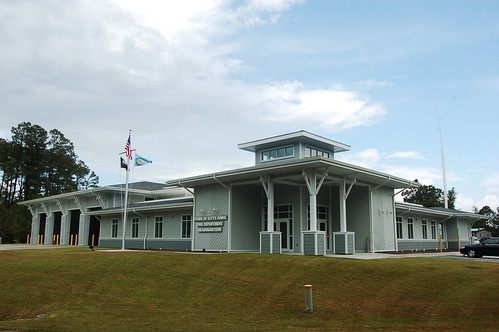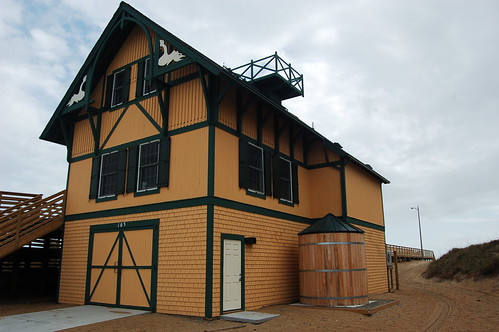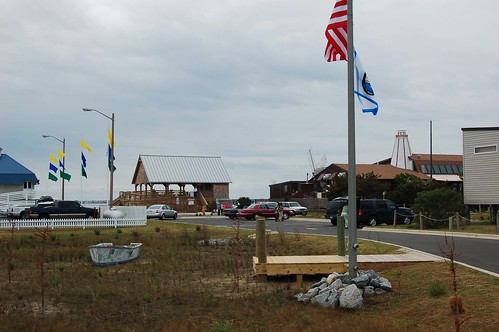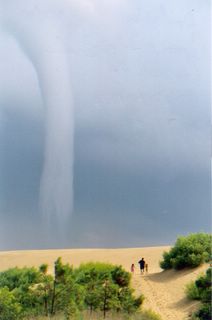Government Goes Green or (where's the stormwater?)
 Nice article in the VA. Pilot about the green trend in public buildings. Congratulations to the governments involved for taking steps (small steps) in dealing with our stormwater problems. The renovations at the Kitty Hawk Fire Station, KDH's regional beach access at Colington Rd. and the new pavilion at Nags Head's Harvey Sound Access all deal with storm water in innovative ways. Public buildings on the Outer Banks have long been used to make demonstrate new technologies and point the way forward for the larger community, The Kern Pitts Center in Southern Shores demonstrates the best in hurricane resistant design and construction, Nags Head's Town hall uses a thermal (water to air) heat pump system that has saved taxpayers thousands of dollars over the years. The newest trend is to address the handling of stormwater. Each building takes a slightly different approach but all offer good examples for commercial and residential development. Additional photos are available at Images from the Ridge. There is also a Flickr set that has descriptions and commentary of the images.
Nice article in the VA. Pilot about the green trend in public buildings. Congratulations to the governments involved for taking steps (small steps) in dealing with our stormwater problems. The renovations at the Kitty Hawk Fire Station, KDH's regional beach access at Colington Rd. and the new pavilion at Nags Head's Harvey Sound Access all deal with storm water in innovative ways. Public buildings on the Outer Banks have long been used to make demonstrate new technologies and point the way forward for the larger community, The Kern Pitts Center in Southern Shores demonstrates the best in hurricane resistant design and construction, Nags Head's Town hall uses a thermal (water to air) heat pump system that has saved taxpayers thousands of dollars over the years. The newest trend is to address the handling of stormwater. Each building takes a slightly different approach but all offer good examples for commercial and residential development. Additional photos are available at Images from the Ridge. There is also a Flickr set that has descriptions and commentary of the images.The KH Fire Station has installed a cistern system and a gravel parking field. Storm water from the building is channeled to an underground storage area then used to fill fire trucks and flush toilets. The parking area features gravel over a sand base with a rigid plastic webbing embedded in the surface. The plastic helps keep the gravel in place and presumably traps some water keeping it from draining across the surface. Parking spaces are marked with concrete dividers and the handicapped spaces are all concrete.
This looks like a good way to slow runoff from a parking lot and avoid the sheet draining that comes with asphalt or concrete lots. There do appear to be some drawbacks. The site is already showing signs of wear. Gravel is missing in patches and clearly going to take a fair amount of maintenance to keep the surface functioning smoothly. I also noticed that erosion had already washed out sections on either side of the entrance apron. Both of these issues are common for gravel surfaces and both of these issues can be addressed by frequent maintenance, a common need of sand and gravel parking areas. Finally, you won't see anyone in spiked heels (not common firefighter footwear) on the parking area, Like open face paving block, another popular eco-friendly paving surface, the fashion conscious will get the heels stuck in the sand if they aren't careful.
 Kill Devil Hills added a cistern to its new to its rebuilt bathhouse and Ocean Rescue facility at the ocean end of Colington Rd. Nice touch. The water will be used for irrigation and gray water uses around the building. The parking lot stormwater still drains on to the beach road since the changes to the site were limited to the building. The Pilot article indicates the new building also has solar panels.
Kill Devil Hills added a cistern to its new to its rebuilt bathhouse and Ocean Rescue facility at the ocean end of Colington Rd. Nice touch. The water will be used for irrigation and gray water uses around the building. The parking lot stormwater still drains on to the beach road since the changes to the site were limited to the building. The Pilot article indicates the new building also has solar panels.
 Nags Head's new Harvey Sound Access is an environmental tour de force. The improvements were dedicated Sat. with though the new building has been in use for almost a year. The site retains 100% of its stormwater. The water is retained in two retention basins that have been planted with native and locally adapted varieties. These plants serve to purify the run off before it goes into the sound. Rainwater from the building goes into a cistern and is then used for irrigation and other gray water uses including flushing toilets. The building also has a solar panel to provide some of the power used at the site. The only element missing is a wind turbine like the one at Coquina Beach, another new green government installation.
Nags Head's new Harvey Sound Access is an environmental tour de force. The improvements were dedicated Sat. with though the new building has been in use for almost a year. The site retains 100% of its stormwater. The water is retained in two retention basins that have been planted with native and locally adapted varieties. These plants serve to purify the run off before it goes into the sound. Rainwater from the building goes into a cistern and is then used for irrigation and other gray water uses including flushing toilets. The building also has a solar panel to provide some of the power used at the site. The only element missing is a wind turbine like the one at Coquina Beach, another new green government installation.
The dedication of the Harvey Access featured remarks by Dr. Nancy White, Director of the UNC Coastal Studies Institute and one of the drivers of this new government environmental consciousness. Her stormwater committee recommended many of the improvements the governments have incorporated. Solving local stormwater problems through site design was a major thrust of the committee report. This philosophy was reflected in KH Fire Chief Lowell Spivey's comments in the Pilot article:
Before the new 15,260-square-foot fire station was built, the nearby road tended to flood in rainstorms, Fire Chief Lowell Spivey said.
So when the building went up, three vast tanks were installed underground. Rain travels from gutters to tanks to fill fire engines, water lawns and help flush toilets. The only impermeable pavement is the bay driveway, and trench drains catch and filter runoff.
By joining two pockets of wetlands - which eventually empty into the sound - water doesn't stand on the property as long, Spivey said.
This type of construction isn't cheap. In fact it costs more than the standard building practices required by code and zoning ordinances, much more. Most towns have no standards for residential stormwater, adding standards has been resisted by the building community and elected officials who aren't inclined to make new homes even more expensive to build than they are already . Additionally, many of the initial recommendations from the public to deal with residential flooding conflict with other core values like protecting structures from ocean and sound flooding. The governments have taken a first step and set a good example. The next step will be to find ways to encourage these improvements in new residential and commercial construction. As the brief history of Duck's tree preservation ordinance demonstrates its not so easy being green.
It will get even harder for governments to be green with fiscal pressure from declining land transfer tax revenues. Don't expect to see another round of eco-add-ons until the tax coffers are overflowing again. Elected leaders love the environment as long is at doesn't mean raising taxes. Go enjoy the new buildings then make sure you tell somebody that you think its a worthwhile way to spend money and it should become to norm for private as well as public building. You will be helping us all in the long run.
Tags: Outer Banks, OBX, storm water, environment, green design, runoff








0 Comments:
Post a Comment
<< Home